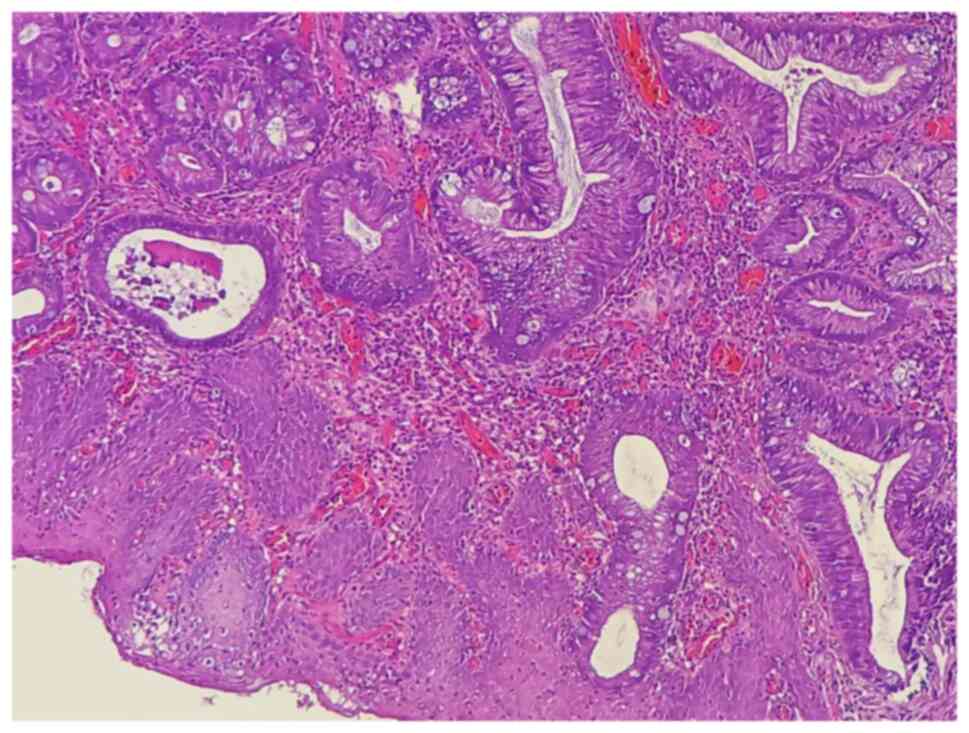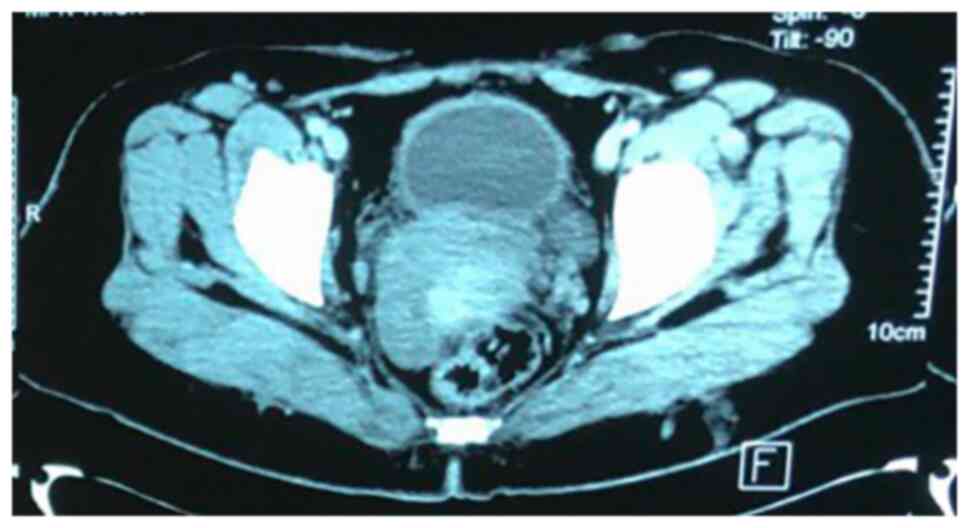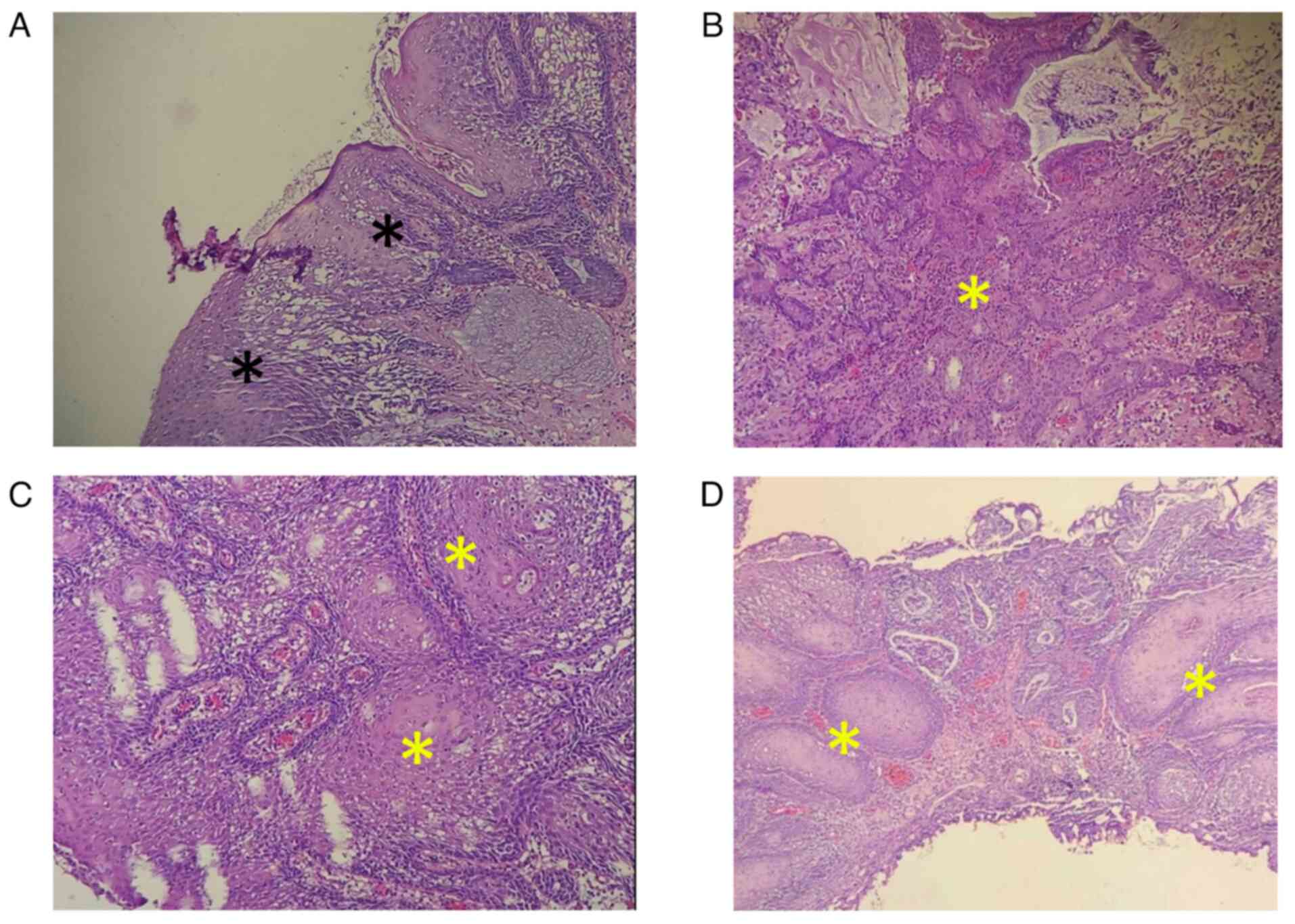Urinary bladder collision tumors: A case report and literature review
- Authors:
- Published online on: March 7, 2025 https://doi.org/10.3892/mi.2025.225
- Article Number: 26
-
Copyright : © Omar et al. This is an open access article distributed under the terms of Creative Commons Attribution License [CC BY 4.0].
Abstract
Introduction
Collision tumors refer to the occurrence of two distinct tumors within the same organ or mass, each with separate cellular lineages and genetic origins, but lacking a visible transitional zone between them. This phenomenon is most commonly observed in organs such as the liver, stomach, adrenal glands, ovaries, lungs, kidneys and colon (1).
A collision tumor of the urinary bladder refers to a very rare condition in which two distinct types of tumors occur simultaneously within the same bladder. These tumors may have different origins and growth patterns, and they may be benign or malignant. The coexistence of two different tumor types in the same location is what distinguishes a collision tumor from a composite tumor, in which different cell types from the same tissues are involved (2,3). The most common combination observed in bladder cancer collisions is the concurrent presence of urothelial carcinoma, which is the most common subtype of malignant bladder tumors, and another type of tumor, such as adenocarcinoma, squamous cell carcinoma (SCC) and other subtypes (4,5). Urothelial carcinoma is the most common primary histological type involving the urinary bladder, which comprises 90 to 95% of the primary malignancies, while the other non-urothelial carcinomas, e.g., adenocarcinoma, SCC, neuroendocrine carcinoma and lymphoma, are uncommon and often diagnostically challenging (6,7). Both adenocarcinoma and SCC account for 0.5-2% and 1-3% of the primary bladder malignancies, respectively (8,9). Oncogenic factors, such as p53, VEGF and EGFR, are known to play critical roles in the signal transduction pathways of collision tumors. Based on whether cancer cells can infiltrate the muscular layer of the bladder, bladder cancer is divided into two subtypes, namely non-muscle invasive bladder cancer (NMIBC) and muscular invasive bladder cancer (MIBC). The transurethral resection of bladder tumor (TURBT) is the primary treatment modality for NMIBC (10).
The present study reports and discusses a very rare case of a bladder collision tumor. The references have been inspected for reliability, and the report has been written according to the CaReL guidelines (11,12).
Case report
Patient information
A 43-year-old female patient with a history of vesical stones was referred to the Rzgary Oncology Clinic at Rzgary Teaching Hospital (Erbil, Iraq) after being diagnosed with bladder carcinoma.
Clinical findings
The medical history of the patient included controlled diabetes mellitus, hypertension and multiple sessions of cystoscopic laser lithotripsy, as well as open vesical stone extractions. She had previously undergone a cystoscopy-directed TURBT to remove a mass from the urinary bladder, and a histopathological examination of the biopsy (performed at Rzgary Oncology Laboratory), identified the tumor as a moderately differentiated T2 adenocarcinoma (Fig. 1). Following this, the patient was referred to the Smart Health Tower (Sulaymaniyah, Iraq) for further management.
Diagnostic assessment
Initial diagnostic workup included an abdominal ultrasound (U/S), which was followed by a contrast-enhanced computed tomography (CT) scan as the previous surgery had been based on the U/S alone. The CT scan was performed to provide a more detailed assessment of the bladder wall and surrounding structures, which revealed irregular, thickened bladder walls (8 mm), but no gross mass lesion due to the previous TURBT procedure (Fig. 2). Given the history of adenocarcinoma and to assess potential metastasis, a fluorodeoxyglucose positron emission tomography (FDG-PET) was recommended by the multidisciplinary team. The FDG-PET was crucial for detecting any hypermetabolic nodular lesions suggestive of metastatic spread; however, the results revealed no abnormal focal hypermetabolic nodular lesions in the urinary bladder wall or elsewhere in the body (Fig. 3). Based on the PET scan findings and the initial TURBT biopsy, which revealed a T2-stage adenocarcinoma, a radical cystectomy was advised for definitive management.
Therapeutic intervention
The patient underwent radical cystectomy, during which gross examination revealed a shrunken bladder (7x10 cm) with a pale lesion at the trigone measuring approximately 25 mm. The excised bladder specimen was fixed in 10% neutral-buffered formalin at room temperature for 24 h before being processed using the DiaPath Donatello automated tissue processor. The tissue underwent dehydration in a graded alcohol series, clearing in xylene and paraffin infiltration, followed by embedding in paraffin wax using the Sakura Tissue-Tek embedding center. Paraffin-embedded sections, 5-µm thick, were obtained using the Sakura Accu-Cut SRM microtome, floated in a 40-50˚C water bath, and mounted on glass slides. The slides were then baked at 60-70˚C overnight before staining with hematoxylin and eosin (H&E) (Bio Optica Co.) for 1-2 min at room temperature using the DiaPath Giotto autostainer. The stained slides were examined under a light microscope (Leica Microsystems GmbH). A histopathological examination (HPE) revealed a marked ulceration at the trigone with necrosis extending into the muscle layer. Extensive squamous metaplasia throughout the bladder, SCC in situ, and foci of superficially invasive SCC were observed (Fig. 4). Glandular metaplasia with dysplasia was also noted, extending into the distal bladder, which exhibited significant inflammation and degenerative changes. Additionally, two perivesical nodes were found to be free of malignancy, and 18 lymph nodes were found after sectioning the right and left pelvic nodes, and all were clear of malignancy. On the TURBT, there was no residual adenocarcinoma. The final TNM stage was poorly differentiated adenocarcinoma pT2 N0 M0 and well-differentiated SCC T1 N0 M0 as a collision tumor. This combination of adenocarcinoma and SCC within the same mass is a hallmark of collision tumors, underscoring the multifocal and independent origins of each tumor type.
Follow-up
The patient is under an extensive follow-up regimen, which includes regular urine cytology, liver function tests, and monitoring of creatinine and electrolytes. Imaging studies of the chest, urinary tract, abdomen and pelvis are also performed periodically. Additionally, annual vitamin B12 monitoring is conducted. No recurrence was observed after 1 year of follow-up.
Discussion
While the case presented herein is unique in its specifics, the literature review highlighted several cases of urinary bladder collision tumors in patients aged 50 to 74 years, with most cases involving male patients. Common symptoms included hematuria, sometimes accompanied by urinary urgency, dysuria, or the presence of blood clots. Diagnostic imaging techniques, such as CT scans, ultrasounds and MRIs, have been frequently employed to identify the tumors and assess their extent. Surgical interventions were the primary treatment methods, including TURBT and radical cystectomy, often combined with pelvic lymph node dissection. In some instances, additional treatments such as chemotherapy or immunotherapy were utilized to manage the disease. Patient outcomes varied; while some patients experienced recurrence or metastasis, leading to further complications or mortality, others had successful surgeries and remained free from recurrence for several months to years following treatment. The majority of cases (60%) were found to result in either recurrence or mortality, while 2 cases exhibited no recurrence following an average follow-up period of 6.5 months (2,10,13-15) (Table I). By contrast, the patient in the present study remained free from recurrence during follow-up. It is noteworthy that, although the cases reviewed predominantly involve male patients, the present case pertains to a female patient, thereby contributing to the diversity in the clinical presentation of bladder collision tumors.
Collision tumors may exhibit diverse origins and growth patterns, often involving two distinct tumor types that originate independently within the same mass. This combination of adenocarcinoma and SCC in the present study within the same mass is a hallmark of collision tumors, underscoring the multifocal and independent origins of each tumor type (2). In contrast to collision tumors, composite tumors involve different cell types from the same tissues. The most frequently observed combination in bladder collision tumors, as in the present case, is the simultaneous presence of urothelial carcinoma and another type of tumor, such as adenocarcinoma, or SCC (3). Adenocarcinoma of the bladder emerges from the glandular cells of the bladder. Unlike the more prevalent transitional cell carcinoma type, it is less common. It can be in different areas of the bladder, such as the mucosal layer and deeper muscle layers (16). Cigarette smoking increases the risk of bladder cancer, as harmful chemicals in tobacco smoke are absorbed into the bloodstream and excreted through the kidneys, exposing the bladder lining to carcinogens. Bladder cancer is more common in older adults, especially men. Occupational exposures to chemicals such as aromatic amines and polycyclic aromatic hydrocarbons, found in industries such as rubber, dye, and chemical production also increase the risk. Prolonged exposure to chemicals in textiles, paints, and plastics, along with chronic urinary infections, can further increase this risk. Additionally, radiation therapy, certain diabetes medications, and chronic Schistosoma haematobium infection are linked to higher bladder cancer risk (17,18). The starting point of the disease is a genetic mutation, which can lead to uncontrolled cell growth and division. These mutations can be inherited or occur spontaneously during a person's lifetime; chronic inflammation and long-term inflammation in an organ can create an environment that promotes the growth of cancer cells (19). The signs and symptoms of bladder collision tumors can vary. The urine may appear pink, red, or dark brown, and the presence of blood can be intermittent or consistent; also, there may be painful urination, urinary urgency, and pelvic pain (4). In the present study, the patient was diagnosed with bladder carcinoma and was referred to the Rzgary Oncology Clinic.
The diagnosis of bladder carcinoma often involves various tests, such as urine analysis, imaging studies, and cystoscopy. A biopsy is the gold standard for the diagnosis (12). Since this type of cancer is mostly diagnosed in the advanced stages and is associated with high recurrence rates, the understanding of gene expression regulation is significant for early diagnosis and treatment. Epigenetic modifications, which alter gene expression without changing the DNA sequence, have been extensively studied as flexible and important therapeutic targets for cancer treatments. Mutations in genes such as FGFR3, PIK3CA, KDM6A and TP53 are common in bladder cancers and disrupt normal gene regulation and cell growth, leading to uncontrolled cell growth and tumor formation (20). The case described herein underwent a CT scan with IV contrast followed by a PET scan. The HPE of the specimen confirmed the diagnosis.
The management of bladder collision tumors includes cancer staging and grading, the assessment of the overall health of the patient and the consideration of the preferences of the patient. A general outline of the management options for collision bladder is TURBT, which is the standard initial treatment for non-invasive or early-stage bladder cancer, radical cystectomy, intravesical therapy and radiation therapy. Chemotherapy and immunotherapies are used in the advanced stages. Some bladder cancers with specific molecular features may be treated with targeted therapies that aim to inhibit specific abnormal proteins or pathways involved in cancer growth (21,22). This case undergone radical cystectomy as far as it was a localized early-stage disease.
Early detection and appropriate treatment are crucial for better outcomes in bladder carcinoma. Regular check-ups and prompt medical attention for concerning symptoms can improve prognosis and increase the likelihood of successful treatment. As with any type of cancer, a multidisciplinary approach involving urologists, oncologists and other healthcare specialists is often necessary to provide comprehensive care to individuals affected by bladder carcinoma (5). Although it is a rare disease, regular follow-up is necessary in cases of bladder cancer (13-16,23). The case in the present study was kept on an extensive and regular follow-up schedule by conducting urine cytology, liver function tests, serum creatinine and electrolytes.
In conclusion, collision tumor of the bladder is a rare disease; extensive radiological study and careful examination of the biopsy are necessary to diagnose the condition.
Acknowledgements
Not applicable.
Funding
Funding: No funding was received.
Availability of data and materials
The data generated in the present study may be requested from the corresponding author.
Authors' contributions
SSO and SSF were the major contributors to the conception of the study, as well as in the literature search for related studies. HOA, FHK and BAA were involved in the literature review, in the writing of the manuscript, and in the analysis and interpretation of the patient's data. AMA, BOM, AAQ, SHK and JIH were involved in the literature review, in the design of the study, in revision of the manuscript and in the processing of the figures. RMA was the pathologist who performed the histopathology diagnosis. SHT was the radiologist who performed the assessed the case. SSO and FHK confirm the authenticity of all the raw data. All authors have read and approved the final manuscript.
Ethics approval and consent to participate
The patient provided written informed consent to participate and publish any related data in the present study.
Patient consent for publication
The patient provided written informed consent to participate and publish any related data in the present study.
Competing interests
The authors declare that they have no competing interests.
References
|
Abdullah AM, Qaradakhy AJ, Ali RM, Ali RM, Mahmood YM, Omar SS, Nasralla HA, Muhialdeen AS, Saeed YA, Dhair HM and Mohammed RO: Thyroid collision tumors: A systematic review. Barw Medical J. 2:44–56. 2024. | |
|
Gandhi JS, Pasricha S and Gupta G: Collision tumor of the urinary bladder comprising large cell neuroendocrine carcinoma and adenocarcinoma. Asian J Oncol. 3:144–146. 2008. | |
|
Miyazaki J and Nishiyama H: Epidemiology of urothelial carcinoma. Int J Urol. 24:730–734. 2017.PubMed/NCBI View Article : Google Scholar | |
|
Radović N, Turner R and Bacalja J: Primary ‘pure’ large cell neuroendocrine carcinoma of the urinary bladder: A case report and review of the literature. Clin Genitourin Cancer. 13:375–e377. 2015.PubMed/NCBI View Article : Google Scholar | |
|
Rouanne M, Loriot Y, Lebret T and Soria JC: Novel therapeutic targets in advanced urothelial carcinoma. Crit Rev Oncol Hematol. 98:106–115. 2016.PubMed/NCBI View Article : Google Scholar | |
|
Ploeg M, Aben KK, Hulsbergen-van de Kaa CA, Schoenberg MP, Witjes JA and Kiemeney LA: Clinical epidemiology of nonurothelial bladder cancer: Analysis of the Netherlands Cancer Registry. J Urol. 183:915–920. 2010.PubMed/NCBI View Article : Google Scholar | |
|
Tavora F and Epstein JI: Bladder cancer, pathological classification and staging. BJU Int. 102:1216–1220. 2008.PubMed/NCBI View Article : Google Scholar | |
|
Loriot Y, Necchi A, Park SH, Garcia-Donas J, Huddart R, Burgess E, Fleming M, Rezazadeh A, Mellado B, Varlamov S, et al: Erdafitinib in locally advanced or metastatic urothelial carcinoma. N Engl J Med. 381:338–348. 2019.PubMed/NCBI View Article : Google Scholar | |
|
Catto JW, Yates DR, Rehman I, Azzouzi AR, Patterson J, Sibony M, Cussenot O and Hamdy FC: Behavior of urothelial carcinoma with respect to anatomical location. J Urol. 177(1715)2007.PubMed/NCBI View Article : Google Scholar | |
|
Jiang W, Pan C, Guo W, Xu Z, Ni Q and Ruan Y: Pathologic collision of urinary bladder urothelial carcinoma with small cell carcinoma: A case report. Diagnostic Pathology. 18(80)2023.PubMed/NCBI View Article : Google Scholar | |
|
Abdullah HO, Abdalla BA, Kakamad FH, Ahmed JO, Baba HO, Hassan MN, Bapir R, Rahim HM, Omar DA, Kakamad SH, et al: Predatory Publishing Lists: A Review on the Ongoing Battle Against Fraudulent Actions. Barw Med J. 2:26–30. 2024. | |
|
Prasad S, Nassar M, Azzam AY, García-Muro-San José F, Jamee M, Sliman RKA, Evola G, Mustafa AM, Abdullah HO, Abdalla BA, et al: CaReL guidelines: A consensus-based guideline on case reports and literature review (CaReL). Barw Med J. 2:13–19. 2024. | |
|
Brinton JA, Ito Y and Olsen BS: Carcinosarcoma of the urinary bladder. A case report and review of the literature. Cancer. 25:1183–1186. 1970.PubMed/NCBI View Article : Google Scholar | |
|
Chen X, Ge H, Yang J, Huang B and Liu H: Primary malignant melanoma of the bladder collides with high grade non invasive urothelial papillary carcinoma: A case report. Oncol Lett. 24:1–5. 2022.PubMed/NCBI View Article : Google Scholar | |
|
Kitazawa M, Kobayashi H, Ohnishi Y, Kimura K, Sakurai S and Sekine S: Giant cell tumor of the bladder associated with transitional cell carcinoma. J Urol. 133:472–475. 1985.PubMed/NCBI View Article : Google Scholar | |
|
Dadhania V, Czerniak B and Guo CC: Adenocarcinoma of the urinary bladder. Am J Clin Exp Urol. 3(51)2015.PubMed/NCBI | |
|
Taguchi S, Akamatsu N, Nakagawa T, Gonoi W, Kanatani A, Miyazaki H, Fujimura T, Fukuhara H, Kume H and Homma Y: Sarcopenia evaluated using the skeletal muscle index is a significant prognostic factor for metastatic urothelial carcinoma. Clin Genitourin Cancer. 14:237–243. 2016.PubMed/NCBI View Article : Google Scholar | |
|
Ku JH, Byun SS, Jeong H, Kwak C, Kim HH and Lee SE: Lymphovascular invasion as a prognostic factor in the upper urinary tract urothelial carcinoma: A systematic review and meta-analysis. Eur J Cancer. 49:2665–2680. 2013.PubMed/NCBI View Article : Google Scholar | |
|
Roy S and Parwani : AVA8/arpa.2009-0713-RS adenocarcinoma of the urinary bladder. Arch Pathol Lab Med. 135:1601–1605. 2011.PubMed/NCBI View Article : Google Scholar | |
|
Lee KH and Song CG: Epigenetic regulation in bladder cancer: Development of new prognostic targets and therapeutic implications. Translational Cancer Res. 30 (Suppl):677–688. 2017. | |
|
Crabb SJ and Douglas J: The latest treatment options for bladder cancer. Br Med Bull. 128:85–95. 2018.PubMed/NCBI View Article : Google Scholar | |
|
Witjes JA: Bladder carcinoma in situ in 2003: State of the Art. Eur Urol. 45:142–146. 2004.PubMed/NCBI View Article : Google Scholar | |
|
Mingomataj E, Krasniqi M, Dedushi K, Sergeevich KA, Kust D and Qadir AA: Cancer Publications in one year (2023): A cross-sectional study. Barw Med J. 2(3)2024. |













